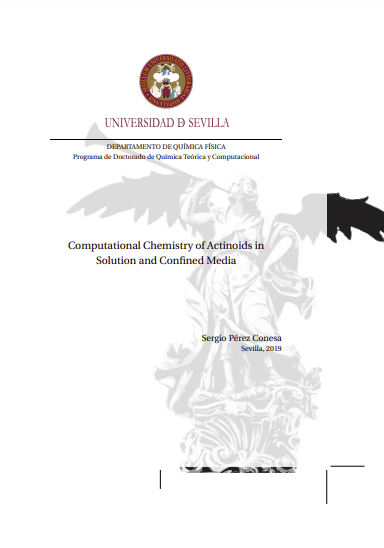Computational chemistry of actinoids in solution and confinedMedia
Licencia: Creative Commons (by-nc-nd)
Autor(es): Pérez, Sergio; [et al.]
The nuclear power industry accounts for around 10% of the electricity production worldwide and up to 70% in some countries.1 One of the problems of this otherwise clean energy source is the generation of high level radioactive waste which remains harmful for centuries.2 Spent nuclear fuel is reprocessed to extract the actinoids that are still fissile (U and Pu) from highly radiotoxic minor actinoids (Np and Am). 2-4 This is done typically through the PUREX process which is based on liquid-phase extraction of actinoids based on their physico-chemical properties. Some of the most important species in this process are the actinyl hydrated cations, [AnO2 ¢(H2O)5]2+/+(aq)] for An=U,Np,Pu,Am. The actinyls are linear oxo-cations formed by the oxidation states V and VI of the metal. High level radioactive waste resulting from the PUREX process are destined to be kept underground in permanent geological repositories for the centuries to come.2 These repositories use clays as liner materials to prevent potential diffusion of radioelements to the environment.5 The main clay component is montmorillonite clay.5 In this thesis we will study the physico-chemical properties of actinyl cations in aqueous solution and in clays using computational chemistry . In order to run molecular dynamics simulations (MD), ab initio force fields were developed for U(VI), Np(VI), Np(V), Pu(VI) and Am(VI) in water. One additional force field was developed for the interaction of uranyl with the montmorillonite clay aluminosilicate layers. The force fields are based on the hydrated ion model6-8 developed by the group in the mid 90's. This model accounts for many-body effects like polarization and charge transfer in a nonpolarizable framework. Its main characteristic is to consider the hydrated ion and not the naked ion as the solute. In this way, first-shell water molecules and bulk water molecules are different species. This allows the assignment of different atom types, partial charges and interaction potentials to the first-shell than to bulk water molecules. It additionally parametrizes explicitly hydrated ion bulk-water molecule interactions. Once the force fields were developed, MD simulations of the actinyls in water were run. The simulations reproduced satisfactorily a wide variety of physico-chemical properties of the system: hydration enthalpy, vibrational spectra, diffusion coefficients, XAS spectra etc. This was a sign of the robustness of our force field development strategy. The first conclusion drawn from the simulations is that the solvation structure of the different actinoids is almost indistinguishable one from the other. Furthermore, despite the charge difference between [NpO2]2+ and [NpO2]+, their solvation resembled strongly. We observed that the equatorial solvation of the actinyls was equal to most conventional cations: the first-shell forms two hydrogen bonds with bulk water molecules. In contrast, the Oyl atom solvates hydrophobically: water molecules surround it forming hydrogen bonds with other solventmolecules but not with Oyl . We concluded that the actinyl cations are highly anisotropic amphiphillic cations that have a conventional hydration sphere caped at the poles by hydrophobic solvation regions. The theoretical EXAFS spectra of the actinyls were calculated and compared to experiment. Except for uranyl, the spectra had an improvable correspondence with experiment. The force fields for these cations were developed at the DFT level of theory. With the aimof improving performance, the explicit treatment of static correlation was then taken into account. A NEVPT29-11 force field was developed as well as a strategy to modify the DFT force fields to include the small changes in distances of the higher level. The effect of this increase in level of theory was studied, and the decomposition of the complex EXAFS signal was shown to be useful in the understanding of themain EXAFS spectrumfeatures. Due to its chemical instability, americyl ([AmO2]2+), has never been isolated in aqueous solution. As a result, the only EXAFS spectrum of [AmO2]2+ corresponds to a 70/30 mixture of americyl and Am3+.13 We simulated the EXAFS spectra of both species fromtheir respectiveMDsimulations andweighted them into a single spectrum to produce a simulated EXAFS of a mixture of species. The good comparison of the simulated spectrum and experiment allowed us to predict theoretically the structural parameters and EXAFS spectrumof a pure americyl solution, a solution yet to be obtained experimentally. The same procedure was applied to XANES spectra. This work was featured in the cover of Inorganic Chemistry, Figure 1. The MD simulations of the uranyl hydrated ion in the aqueous interlayers of montmorillonite clays gave interestingmicroscopical details of the system hard to obtain experimentally. The simulations reproduced the few experimental microscopical information of the system: the uranyl hydrated ion interacts with the surface through the formation of an outer-shell complex14 and the uranyl axis is neither perpendicular nor parallel to the surface.15 We calculated for the first time from aMD simulation the constrictivity factor, ±int , which was found to be near the right order of magnitude to experiment. Strong interaction sites for uranyl were found on the clay. These sites are groups of three magnesium substitutions around which uranyl cations appear to have deep free energy wells. As a consequence the diffusion of uranyl in the clay exhibits a hopping diffusion mechanism. Because of this, the diffusion of uranyl increases with increasing uranyl concentration due to cation-cation interactions and a larger coverage of surface sites. This work was featured in the cover of Inorganic Chemistry. Finally, a simple local fingerprint for hydrophobicity/hydrophilicity was developed. This fingerprint is inspired by the expansion of the entropy of a system as a sumof terms of increasing correlational order.17,18 The fingerprint measures the hydrophobicity/hydrophillicity of individual atoms of a solute taking as input its radial distribution function with water. The fingerprint classifies satisfactorily, the atoms of the amino acids. Nevertheless, the fingerprint hasmixed results in classifying the atoms of the actinyl pentahydrates. A future improved fingerprint should probably make use of orientational pair entropy in addition to some technique to consider the anysotropicity of the solute in complex environments. Additionally, the fingerprint proved to be a useful solvation/desolvation collective variable for enhanced sampling simulations.
[2019]
Compartir:
Una vez que el usuario haya visto al menos un documento, este fragmento será visible.


